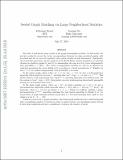| dc.contributor.author | Mossel, Elchanan | |
| dc.contributor.author | Xu, Jiaming | |
| dc.date.accessioned | 2021-11-09T15:19:02Z | |
| dc.date.available | 2021-11-09T15:19:02Z | |
| dc.date.issued | 2018-07 | |
| dc.identifier.uri | https://hdl.handle.net/1721.1/137916 | |
| dc.description.abstract | Copyright © 2019 by SIAM We study a well known noisy model of the graph isomorphism problem. In this model, the goal is to perfectly recover the vertex correspondence between two edge-correlated graphs, with an initial seed set of correctly matched vertex pairs revealed as side information. Specifically, the model first generates a parent graph G0 from Erdos-Rényi random graph G(n, p) and then obtains two children graphs G1 and G2 by subsampling the edge set of G0 twice independently with probability s = Θ(1). The vertex correspondence between G1 and G2 is obscured by randomly permuting the vertex labels of G1 according to a latent permutation π∗. Finally, for each i, π∗(i) is revealed independently with probability α as seeds. In the sparse graph regime where np ≤ n for any < 1/6, we give a polynomial-time algorithm which perfectly recovers π∗, provided that nps2 − log n → +∞ and α ≥ n−1+3. This further leads to a sub-exponential-time, exp nO(), matching algorithm even without seeds. On the contrary, if nps2 − log n = O(1), then perfect recovery is information-theoretically impossible as long as α is bounded away from 1. In the dense graph regime, where np = bna, for fixed constants a, b ∈ (0, 1], we give a polynomial-time algorithm which succeeds when b = O(s) and α = Ω (np)−b1/ac log n. In particular, when a = 1/k for an integer k ≥ 1, α = Ω(log n/n) suffices, yielding a quasi-polynomial-time nO(log n) algorithm matching the best known algorithm by Barak et al. for the problem of graph matching without seeds when k ≥ 153 and extending their result to new values of p for k = 2, . . ., 152. Unlike previous work on graph matching, which used small neighborhoods or small subgraphs with a logarithmic number of vertices in order to match vertices, our algorithms match vertices if their large neighborhoods have a significant overlap in the number of seeds. | en_US |
| dc.language.iso | en | |
| dc.rights | Creative Commons Attribution-Noncommercial-Share Alike | en_US |
| dc.rights.uri | http://creativecommons.org/licenses/by-nc-sa/4.0/ | en_US |
| dc.source | arXiv | en_US |
| dc.title | Seeded Graph Matching via Large Neighborhood Statistics | en_US |
| dc.type | Article | en_US |
| dc.identifier.citation | Mossel, Elchanan and Xu, Jiaming. 2018. "Seeded Graph Matching via Large Neighborhood Statistics." | |
| dc.contributor.department | Massachusetts Institute of Technology. Department of Mathematics | |
| dc.contributor.department | Massachusetts Institute of Technology. Institute for Data, Systems, and Society | |
| dc.eprint.version | Original manuscript | en_US |
| dc.type.uri | http://purl.org/eprint/type/ConferencePaper | en_US |
| eprint.status | http://purl.org/eprint/status/NonPeerReviewed | en_US |
| dc.date.updated | 2019-11-18T13:31:41Z | |
| dspace.date.submission | 2019-11-18T13:31:44Z | |
| mit.metadata.status | Authority Work and Publication Information Needed | en_US |
